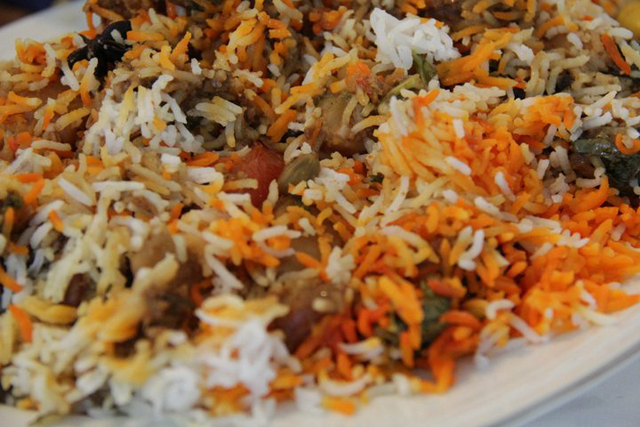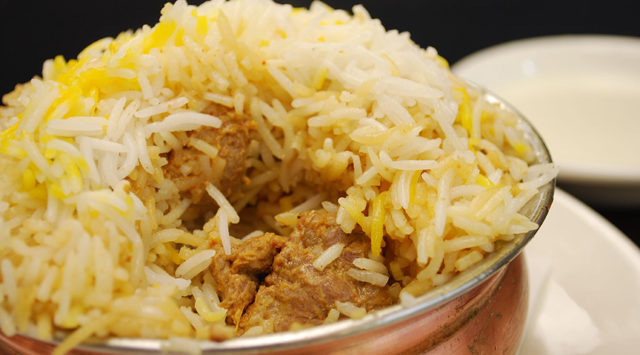If you plan on traveling to Pakistan anytime soon, one of the many dining options available to you will be a traditional Persian dish called Biryani. It may sound exotic, but chances are you’ve had a variation of this dish in other parts of the world, whether it’s Nasi kebuli in Indonesia, or dum pukht in Burma. The dish itself is not very elaborate, but it’s the combination of all the different ingredients, as well as the cultural add-ons that make it unique.
There are only three main components – spice, rice, and meat – and dates back to the founding of the Persian empire nearly 4,000 years ago. The word “biryani” actually stems from the word “biryan” or “beriyan” which means to fry or to roast.
The meat changed amongst the different social classes, as well as amongst different cultures. For instance, in Central Asia, the more elite classes used goat meat as the primary meat ingredient since it was more expensive, whereas the lower classes used beef. This created a dish known as pulao, a forerunner of the modern-day biryani.
According to some historians, the modern biryani came about in the kitchens of the royal Mughal empire (1526-1857 AD), as a fusion of the spicy rice dishes from India and the Persian pilaf. However, even though all of these spices originated in Persia, the burgeoning cross-nation trade routes made it possible for Arabs to acquire it as well through trade. Others will contest that biryani has gone by many names and that there are no distinctions between them; pilaf and others are just the ancient names for biryani.
One of the more famous legends surrounds Mumtaz Mahal, who is the queen of Shah Jahan and inspired the building of the Taj Mahal. According to tradition, Mumtaz visited the army barracks and found the men looking rather lackluster. Moved with compassion for the soldiers, she instructed the cooks to create a dish that combined meat and rice for balanced nutrition, as well as making it delicious. The result? Biryani.
Regardless, the true emphasis of biryani is in its pan-Indian significance: wherever there is a Muslim population in India, you will find biryani. No longer the exclusive choice of royalty, biryani is enjoyed by all classes equally.

The convenience of biryani made it especially popular amongst soldiers, who could create a “one-pot meal” using rice and whatever meat happened to be locally available. The name biryani came to represent a specific type of one-pot meal, unique to the spices included, and pilaf used a different set-up.
The main difference between biryani and other forms of rice-based meals is in the layering of the three foods. With biryani specifically, the top and bottom layers are rice, with the middle layer being meat. With pulao, there is no such layering. The food is simply put together in one big pot.
The eclectic nature of biryani is what makes it so appealing to so many different regions, and every different locale has their own spin on the traditional dish. Below are some examples:
Mughal Biriyani – The traditional dish of the Mughal Emperors, Mughal Biriyani combined succulent chunks of spiced meat and wrapped inside kewra rice. The Mughals viewed cooking as an art, and this dish certainly reflected their passion.
Hyderabadi Biriyani – After Niza-Ul-Mulk was appointed the new ruler of Hyderabad, one of his first orders of business was to create his own version of biryani. His chefs went to work right away, creating nearly fifty variations that included fish, shrimp, quail and even rabbit. Ironically, this variation is unique for its emphasis on the rice, as the saffron aroma bombards the senses with pleasure.

Calcutta Biryani – Nawab Wajid Ali Shah was banished by the British in 1856, but that didn’t mean he had to go without his favorite dish, but his newly-exiled budget forced him to get creative, as meat was too expensive to obtain. The local cooks huddled together, and tweaked the recipe to include potatoes instead of meat. The modern-day version has changed little, but still boasts a slightly hint of sweetness.
Thalassery Biryani – This is one of India’s most beloved versions, and is known for the inclusion of cashews, raisins, and fennel seeds. The rice is cooked apart from the gravy that is traditionally served, and mixed when the dish is presented. Add in some soft, chewy chicken wings, mild Malabar spices, and a specific type of rice known as kaima, and you’ve got a biryani dish fit for a king.
If this list has you licking your chops, but you’re not able to travel to Pakistan to try it, here are a couple recipes that will allow you to make it at home.

Hyderabadi Biryani Recipe
1. First, clean 1kg of meat, and add it in a pan with 1 tbsp salt, 1 tbsp ginger garlic paste, 1 tbsp red chili powder, 1 tbsp green chili paste, 1/2 tbsp cardamom powder, 3-4 sticks of cinnamon, 1 tbsp of cumin seeds, 4 cloves of mace mint, and 2 tbsp of lemon juice. Mix vigorously.
2. Add 250gm of curd, 4 tbsp of clarified butter, 750 gm of semi-cooked rice, 1 tsp saffron rice, 1/2 cup of water and 1/2 cup of oil to mixture.
3. Apply sticky dough to side of pan.
4. Cover with lid to seal and allow to cook for 25 minutes.
Keema Biryani
1. Wash and soak 500 gm of rice.
2. Dry roast 2 tsp cumin seeds, 2 tsp coriander seeds, 3-4 pods of green cardamom, 3-4 sticks of cinnamon, 2 tsp of mace, 1 tsp black peppercorns, and 5-6 cloves. Cool mixture and grind down to a small powder.
3. Blanch 1 cup almonds in water, peeling and cutting into small pieces. Chop 5-6 raisins, and heat 2 tbsp desi ghee in pan and add 1 cup of sliced onions. Cook on low heat.
4. Whisk 1 cup of yogurt, 1 tbsp of garlic pasted, 2 tbsp of coriander powder, 1/2 tsp of ginger paste, black cardamom, and 1 tsp of red chili powder and add to onions. Allow to cook for two minutes.
5. Add 1/2 kg of lamb keema and saute. Add salt and garam masala, and allow to cook.
6. Add one cup of water and allow to simmer. Move keema to another pan, adding 1 glass of milk to almond, butter, and raisin combo.
7. Boil rice. Add rose water and salt, while stirring.
8. Put half of rice on jhol, and add mint and ginger.
9. Put rest of jhol on top and then rice.
10. Cover and allow to cook while hot.

Photo credits : Andrew Brown, Sarah Parvaiz, Shehal Joseph, Alpha
Photo credit : Jessica Spengler – https://flic.kr/p/7Cviom
Photo credit : Brook Peterson – https://flic.kr/p/4Nmkvc



